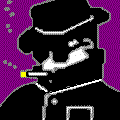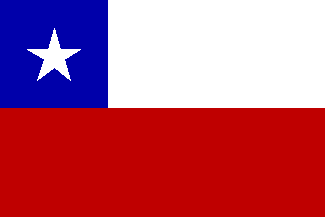



Carabineros
Under the 1980 constitution, the police are referred to as the Forces of Order and Public Security, their role being defined as the maintenance of law and order. There are two separate law enforcement forces: the Carabineros and the Investigations Police. The Carabineros, Chile's uniformed national police, have primary responsibility for public order and safety, crime control, and border security. Although formally under the administrative jurisdiction of the Ministry of Defense, the Carabineros are under the operational control of the Ministry of Interior. The Carabineros forms a potential reserve for the army
and has a paramilitary organization. The Carabineros, a national, 31,000-member paramilitary police force, is organized into three main zones-- Northern, Central, and Southern--with marine and air sections. In addition to law enforcement and traffic management, Carabineros is engaged in narcotics suppression, border control, and counterterrorism.
The Carabineras created a new countersubversive intelligence body in May 1990, the Directorate of Carabineros Political Intelligence (Dirección de Inteligencia de Carabineros--Dipolcar). Its previous unit was implicated in human rights
violations. In the early 1990s Italy and Spain pledged to help Aylwin government finance and train civilian-based security force capable of combatting terrorist threat.
Although the "use of illegal pressure" is forbidden, there
continue to be mistreatment and torture by some Carabinero units. The Constitution allows civilian and military courts to order
detention for up to 5 days without arraignment and extend the
detention for up to 10 days for suspected terrorist acts. By
law, detainees are to be provided 30 minutes of immediate and
daily access to a lawyer (although not in private) and to a
doctor to verify their physical condition. The law does not
permit a judge to deny such access. With few exceptions, this
practice appeared to be observed by police authorities.
Service in the Carabineros is voluntary, and admission standards are high. Applicants are required to
have completed secondary school and to have passed exacting physical examinations and psychological
tests. A highly professional organization, the Carabineros have enjoyed a prestige and universal respect
that are almost unique among Latin American police forces. The force's principal problem at the
beginning of the 1990s was the lack of adequate resources to combat crime. Although budget
appropriations for the Carabineros had risen steadily in the early 1990s (from US$37 million in 1990 to
US$78 million in 1993), low pay and even inadequate clothing were a source of discontent within the
ranks. The force has its own cadet, NCO, and staff officer schools, in addition to a specialists' training
center, all of which are located in Los Cerrillos, Santiago.
History
During the colonial period, there existed a fifty-man
police
unit known as the Queen's Dragoons, which was responsible
for law
enforcement in the Santiago area. This force changed its
name to
Dragons of Chile (Dragones de Chile) in the early years of
the
republic and, by 1850, had increased in strength to 300.
It was
subsequently incorporated into the army as a cavalry
regiment. By
that time, civil police forces had also been set up in the
major
population centers. In 1881 the Rural Police Law created a
separate
rural police force in each province, and six years later
each
municipality was authorized to set up its own local police
force.
In 1902 four of the army's seven cavalry regiments were
ordered
to detach a squadron apiece to form a new entity to be
known as the
Border Police (Gendarmes de la Frontera) and to be engaged
primarily in the suppression of banditry in the less
developed
regions of the country. Despite being administratively and
operationally subordinate to the Ministry of Interior,
this unit
remained ultimately under the jurisdiction of the minister
of war.
Five years later, it acquired a larger establishment and
changed
its name to the Carabineros Regiment (Regimiento de
Carabineros).
Although still lacking a formal permanent institutional
existence, in 1909 the Carabineros established an
Institute of
Instruction and Education, which admitted its first class
of police
cadets in August of that year. Five years later, the
responsibilities of the force were extended to railroad
security.
Finally, in 1919, the force acquired a formal independent
existence
under the Ministry of Interior, and its title was changed
again to
the Carabineros Corps (Cuerpo de Carabineros). Six years
later, by
which time the corps consisted of 204 officers and 3,760
enlisted
personnel, the Carabineros acquired a new organization
that
combined their various independent squadrons into five
Rural
Service Regiments, together with a Railway Regiment,
Training
Regiment, and Customs Squadron, the latter based at
Valparaíso.
The strength, resources, and qualities of the various
municipal
and rural police forces varied enormously. In 1924, in an
effort to
provide a degree of uniformity, the country was divided
into five
police zones, with their headquarters at Antofagasta,
Valparaíso,
Santiago, Talca, and Concepción. The same law divided the
police
functionally into three divisions: the Public Order
Division,
entrusted with general peacekeeping on a relatively
passive level;
the Security Division, with a role of active law
enforcement; and
the Identification Division, which embraced record keeping
and
general crime detection. This arrangement provided for the
coordination of the activities of the various existing law
enforcement agencies, on a zonal basis, with the General
Directorate of Police (Dirección General de Policía) at
the
national level. At that time, in the mid-1920s, the
various police
forces numbered 728 officers and 8,628 enlisted personnel.
Although now downgraded in importance, the provinces
and the
municipalities continued to maintain their individual
police
forces. Only the municipal police of Santiago and
Valparaíso seem
to have been effective, however, and in 1927 all law
enforcement
agencies were incorporated in a single national force, the
Carabineros of Chile. The force had a total strength of
1,123
officers and 15,420 enlisted personnel in 1929.
In 1993 the Carabineros numbered 31,000, including
officers,
noncommissioned officers (NCOs), and a significant women's
element.
Although normally under the jurisdiction of the Ministry
of
Interior, the Carabineros were put under the Ministry of
Defense
during the period of national emergency following the
overthrow of
the Allende regime. Despite the return of civilian
government in
1990, the Carabineros remain subordinate to the Ministry
of
Defense, but their operations are coordinated by the
Ministry of
Interior. The Aylwin administration authorized an increase
in
strength of 1,100 annually over the 1991-94 period.
Organization
The Carabineros are commanded by a director general and organized geographically into three main
zones--the Northern Zone, the Central Zone, and the Southern Zone. Each of these zones is in turn
subdivided into prefectures (prefecturas), subprefectures (subprefecturas), commissariats
(comisarías), subcommissariats (subcomisarías), lieutenancies (tenencias), reserves (retenes), and
outposts (puestos avanzados).
The Carabineros also include marine and air sections. The Air Police, which ranks as a separate
prefecture, dates from 1946, when it was formed with a single Aeronca Champion aircraft. The Air
Police acquired its first helicopter in 1968; by 1993 its inventory of helicopters had increased to fourteen.
Operationally, the Carabineros are divided into seventeen departments: analysis and evaluation,
armaments and munitions, borders and boundaries, civic action, data processing, drug control and
prevention of offenses, finance, forestry, internal security, legal, minors, police services, public relations,
social action, supply, traffic control, and transport. In addition to their normal law enforcement and allied
functions, the Carabineros perform extensive civic action, including the provision of medical and dental
services to the populations of the less developed regions of the country and the protection of forests and
wildlife. The Carabineros are also responsible for customs control and the Presidential Guard. Separate
prefectures deal with the Air Police, the Radio Patrol, and the Special Forces.
The largest single concentration of Carabineros is in Santiago, where apart from headquarters and
administrative personnel, the schools, and the Presidential Guard, there are five geographical prefectures:
the Central Prefecture, North Prefecture, South Prefecture, East Prefecture, and West Prefecture.
These are in turn subdivided into twenty-six territorial and nine operational commissariats.
Chile long remained relatively unaffected either by drug trafficking or by extensive drug abuse. Some
expansion, both of drug trafficking and of narcotics abuse, occurred during the late 1960s and early
1970s, reflecting an international trend. By the early 1970s, Chile had become an important regional
center for cocaine processing. The problem had become sufficiently acute to occasion the passage of the
country's first antinarcotics law by Allende's Popular Unity government early in 1973. Later that year,
the military government formed a special narcotics unit within the Caribineros and began a big
crackdown. This was highly effective, bringing the narcotics problem under control within a year. The
Carabineros also pioneered the introduction of antinarcoticsoriented , youth education programs. A pilot
project was set up in 1976, eight years before any comparable program was initiated in the United States.
Toward the end of the period of military rule, a new form of drug-related crime was noted in the northern
Chilean provinces adjoining the Bolivian and Peruvian frontiers: the illicit exporting to Peru and Bolivia of
chemicals used in the processing of cocaine.
Since the early 1980s, drug trafficking has been growing in Chile. The country has become more prone to
drug trafficking not only because of its geographic configuration and location, bordering on the world's
two leading producers of coca--Peru and Bolivia--but also because of its economic stability. With its
openmarket economy and bank-secrecy laws, Chile is an attractive haven for money laundering. A
number of drug traffickers who were expelled by the military regime after the 1973 coup cultivated
contacts with drug-trafficking groups while living in exile in the United States and Europe. On returning
to Chile to reside, these traffickers, acting as finance men and heads of operations, profited from their
international contacts. Chile served as a good transit country also because of its booming export
activities. In mid-1992 an operational director of the Carabineros reported that money obtained through
drug trafficking was being laundered through the construction industry in central Chile and the fishing
industry in the far south.
In order to enhance the country's antidrug capabilities, the Aylwin government signed several antidrug
agreements in 1992, including one with Italy in October (which also included antiterrorist cooperation)
and one with Bolivia in November. Chile's most serious drug-related problems by 1992 reportedly
involved transit through the country along the northern corridor to Arica. In early 1993, a new
cocaine/cocaine paste drug route reportedly came from Bolivia through the Azapa Valley, an area with a
sizable Bolivian and Peruvian population located to the east of the city of Arica. At that time, the
Investigations Police began implementing a new drug enforcement plan, with the aid of a turbo Cessna
206 for patrolling the area along the Bolivian and Peruvian borders, in coordination with motor vehicles
and twenty powerful all-terrain Cagiva motorcycles, donated by Italy.
Sources and Resources
http://www.fas.org/irp/world/chile/carabineros.htm
Maintained by Steven Aftergood
Created by John Pike
Updated Friday, September 11, 1998 6:11:01 AM



